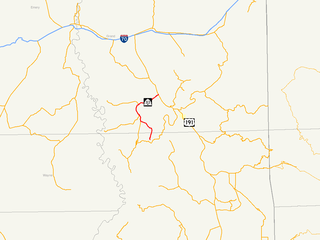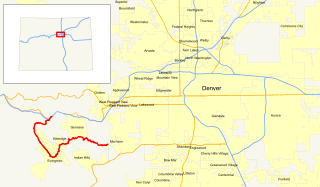Coordinates: 34°22′22.1″N85°41′29.6″W / 34.372806°N 85.691556°W

A geographic coordinate system is a coordinate system that enables every location on Earth to be specified by a set of numbers, letters or symbols. The coordinates are often chosen such that one of the numbers represents a vertical position and two or three of the numbers represent a horizontal position; alternatively, a geographic position may be expressed in a combined three-dimensional Cartesian vector. A common choice of coordinates is latitude, longitude and elevation. To specify a location on a plane requires a map projection.

Little River Canyon Rim Parkway, also known as Alabama State Route 176 , Dekalb County Road 148 and Cherokee County Road 275, forms a 22-mile (35 km) scenic drive following the 16-mile-long (26 km) Little River Canyon National Preserve in northeastern Alabama. The highway was first designated in 1972 as State Route 275 , but was later renumbered to State Route 176 on the northern portion east of former Dekalb County Road 81 and turned back south of former Dekalb County Road 81 in September 1980. [2]
State Route 176 was created in September 1980 along previous County/Secondary State Roads 81 and 89 in DeKalb County and part of County/Secondary State Road 89 in Cherokee County. Part of the route took over what had been State Route 275 and forms the northern end of the Little River Canyon Rim Parkway: a scenic, but severely substandard highway following the northern rim of the limestone canyon for 22 miles (35 km).

Little River Canyon National Preserve is a United States National Preserve located on top of Lookout Mountain near Fort Payne, Alabama, and DeSoto State Park. Created by an Act of Congress in 1992, the 15,288-acre (6,187 ha) preserve protects what is sometimes said to be the nation's longest mountaintop river, the Little River. The canyon was historically called "May's Gulf", "gulf" being a common term throughout the Cumberland Plateau for this sort of feature. Prior to being assigned to the National Park Service, the canyon area formed the southmost unit of Alabama's DeSoto State Park.
State Route 275 (SR-275) is a 8.250-mile (13.277 km) numbered state highway in Alabama. The route is a western and northern bypass route of Talladega. Commissioned in 1990, State Route 275 is the second incarnation of what was originally the designation for the entire Little River Canyon Rim Parkway.
As one of Alabama's most scenic attractions, the highway itself is only well-maintained on the state portion. The turned back portion, which was highly substandard previously, fell into serious disrepair under local control, almost to the point of abandonment. On the small part of the section maintained by Dekalb County, the road is less than two lanes wide. In Cherokee County, the road widens to two narrow lanes, but has miles of broken pavement and potholes. The roadway is also characterized by extremely steep grades both at the Johnnies Creek tributary and where the roadway descends from Lookout Mountain to the Canyon Mouth Park. While the State Route 176 portion has less severe grades, it is designed similarly with sharp curves and a couple sharp dropoffs at the edge of the canyon in some areas.

DeKalb County is a county of the U.S. state of Alabama. As of the 2010 census, the population was 71,109. Its county seat is Fort Payne and it is named after Major General Baron Johan DeKalb.

Cherokee County, Alabama is a county of the U.S. state of Alabama. As of the 2010 census, the population was 25,989. Its county seat is Centre,. The county is named for the Cherokee tribe.

Lookout Mountain is a mountain ridge located at the northwest corner of the U.S. state of Georgia, the northeast corner of Alabama, and along the Tennessee state line in Chattanooga. Lookout Mountain was the scene of the "Last Battle of the Cherokees" during the Nickajack Expedition, which took place in the 18th century, as well as the November 24, 1863 Battle of Lookout Mountain during the American Civil War.
In terms of scenery and attractions, not only does the route cross many seasonal tributaries, but also it has many lookout points, smaller canyons such as Bear Creek, Dees Branch and Johnnies Creek, and a view of the state's highest waterfall, Grace's High Falls. [3] Halfway along the route at Eberhardt Point, the highway passes by the site of Canyonland Amusement Park, an abandoned and mostly demolished park that featured a chairlift into the canyon floor. The existence of Canyonland Amusement Park was the likely reason that the original State Route 275 was created. This was especially notable, because a sign for the park (painted over, but with a Coca-Cola logo) was originally placed in an island in the middle of the road entrance on the southern terminus. Another point of interest is the Canyon Mouth Park, where Little River leaves the canyon just before entering Lake Weiss.
Grace's High Falls is a seasonal waterfall in the US state of Alabama, in Little River Canyon National Preserve. The waterfall is Alabama's highest at 133 feet.

Coca-Cola, or Coke, is a carbonated soft drink manufactured by The Coca-Cola Company. Originally intended as a patent medicine, it was invented in the late 19th century by John Stith Pemberton and was bought out by businessman Asa Griggs Candler, whose marketing tactics led Coca-Cola to its dominance of the world soft-drink market throughout the 20th century. The drink's name refers to two of its original ingredients: coca leaves, and kola nuts. The current formula of Coca-Cola remains a trade secret, although a variety of reported recipes and experimental recreations have been published.
The state portion of the parkway received asphalt for the first time in 2004 (all of the parkway was originally paved with tar and gravel).








